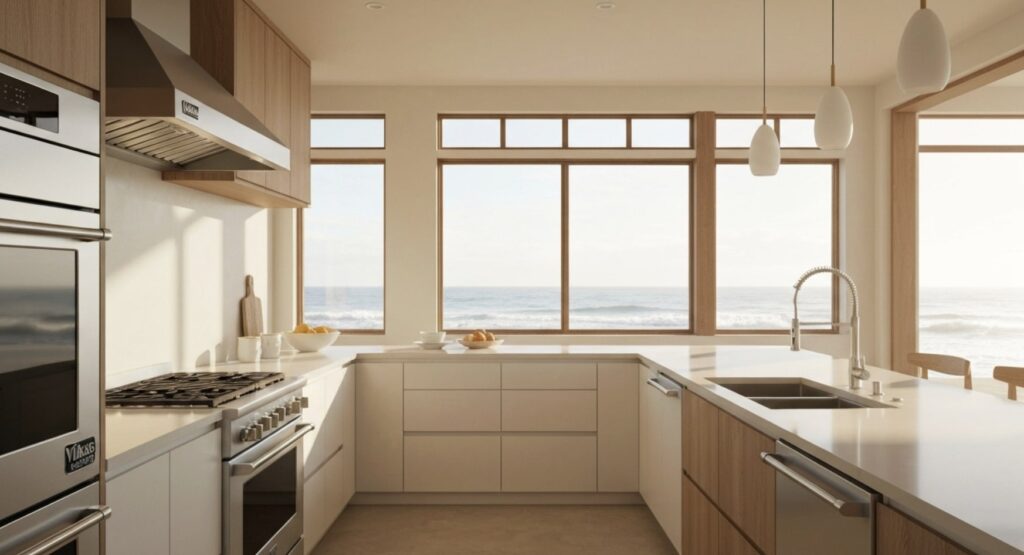Your Viking appliance is the centerpiece of your Santa Monica kitchen, blending high performance with stunning design. But living by the coast brings a unique challenge: the salty sea air that we love can be harsh on stainless steel. That beautiful Viking appliance can be susceptible to rust if not cared for properly. Don’t worry, protecting your investment is easier than you think. This guide provides simple, effective Viking appliance rust prevention tips, keeping your units looking brand new for years to come.
Understanding Rust Risks in Santa Monica Coastal Kitchens
The air in a coastal city like Santa Monica is filled with microscopic salt particles and a higher level of moisture. When this salty, humid air settles on your Viking range or Viking oven, it initiates a chemical reaction that can lead to corrosion over time.
Does humidity in the kitchen increase the risk of rust on Viking appliances? It certainly does. The steam from cooking on your Viking cooktop adds to the ambient humidity, creating an even more challenging environment. This is why proper ventilation is just as important as cleaning.
Seasonal changes also play a part. You might notice more moisture in the air during certain times of the year, which means you may need to be more diligent with your cleaning and protective measures. Understanding these factors is the first step toward effective prevention.
| Environmental Factor | Impact on Viking Appliances |
|---|---|
| High Humidity | Provides the moisture necessary for rust (iron oxide) to form on any compromised steel surfaces. |
| Salt Air | Contains chlorides that actively break down the protective chromium layer on stainless steel. |
| Seasonal Shifts | Fluctuations in humidity and temperature can accelerate or slow down the rate of corrosion. |
Best Practices for Routine Cleaning of Viking Appliances
So, how often should I clean my Viking appliances to avoid rust formation? In a coastal setting, a little extra attention goes a long way. Daily maintenance is key to removing corrosive deposits before they can cause damage to your Viking appliance.
A quick wipe-down of your Viking range or Viking cooktop after each use can prevent food and grease from sitting on the surface. For a more thorough cleaning, a weekly schedule is a good benchmark. This allows you to address any smudges or buildup that occurred during the week and ensures the stainless steel remains protected.
Here are some simple guidelines to follow:
- Daily: Wipe down all exterior surfaces with a soft, dry cloth to remove any moisture or salt deposits from the air. Immediately clean up spills.
- After Each Use: Clean your Viking cooktop surfaces and grates once they have cooled to remove food particles and grease.
- Weekly: Perform a more detailed cleaning using a mild soap and water solution, then dry the appliance completely.
- Bi-weekly/Monthly: Apply a stainless steel cleaner or polish to add a protective layer.
Safe Cleaning Products for Stainless Steel and Specialty Finishes
Choosing the right cleaner is critical. Which cleaning products are safe to use on Viking appliances to prevent rust? The answer is simple: gentle ones. Harsh, abrasive cleaners can do more harm than good by stripping the protective layer from your Viking appliance.
For daily cleaning, a soft cloth with a simple solution of hot, soapy water is your best friend. Always remember to rub in the direction of the metal’s grain to avoid creating tiny scratches. After cleaning, be sure to rinse with a clean, damp cloth and dry the surface of your Viking refrigerator or Viking range completely to prevent water spots.
To keep your appliance looking its best, follow these product tips:
- DO Use: Mild dish soap, warm water, soft cloths, and microfiber towels.
- DO Use: A dedicated stainless steel cleaner for removing fingerprints and adding shine, but limit its use to every few weeks.
- DON’T Use: Cleaners containing bleach, ammonia, or other harsh chlorides.
- DON’T Use: Abrasive tools like steel wool, scouring pads, or stiff brushes.
Protective Strategies to Shield Viking Appliances from Rust
Beyond regular cleaning, you can take proactive steps to create a shield between your Viking appliances and the corrosive coastal air. These protective strategies offer an additional layer of defense, ensuring the long-term beauty and function of your Viking range, cooktop, or oven.
From physical barriers to specialized surface treatments, these methods help minimize the direct impact of salt and moisture. Is it necessary to use special protectants on Viking stainless steel to avoid rust? In a coastal environment, it’s highly recommended. Let’s look at how these strategies work.
The Role of Appliance Covers and Barriers
Creating a “barrier” is a smart way to protect your Viking appliance from the constant exposure to humid, salty air. This doesn’t necessarily mean a physical cover but rather a set of practices that minimize contact with corrosive elements. One of the most effective barriers is proper ventilation.
Using your range hood every time you cook on your Viking cooktop or oven helps pull steam, grease, and moisture out of the air before they can settle on your appliance surfaces. Promptly wiping away any condensation that forms on your appliance also acts as a crucial barrier against moisture damage.
Consider these simple barrier methods:
- Use Your Range Hood: Always turn on your ventilation hood when cooking.
- Wipe Up Moisture: Immediately dry any condensation or spills you see on your Viking appliance.
- Control Kitchen Humidity: If your kitchen is naturally very humid, consider a dehumidifier to create a less corrosive environment.
- Use Splatter Guards: A simple splatter screen can reduce the amount of acidic food and grease that gets on your cooktop surfaces.
Using Stainless Steel Protectants and Sealants
Is it necessary to use special protectants on Viking stainless steel to avoid rust? For Santa Monica residents, the answer is a resounding yes. These products are designed to bolster the natural defenses of your Viking appliance’s finish. Think of them as wax for your car—an invisible shield against the elements.
Products like commercial stainless steel cleaners and polishes do more than just make your Viking refrigerator shine; they leave behind a thin, protective film that helps repel water and resist fingerprints. For grates on a Viking range or Viking cooktop, a light coating of mineral or vegetable oil can condition the metal and provide a barrier against rust.
When applying any protectant, use a small amount on a soft cloth and wipe in the direction of the grain. This ensures even coverage and avoids streaks. Using a polish every few weeks provides a consistent layer of defense, making it much harder for the salty air to cause damage.
Your Viking Deserves the Best—Trust Our Expert Repair Team!
Following these preventative tips is the best way to ensure your Viking appliance stays in pristine condition. Can regular kitchen maintenance reduce long-term rust risk? Without a doubt. Consistent care is your greatest tool. However, sometimes rust can appear despite your best efforts, or an underlying issue might need professional attention. When that happens, you want an expert who understands the intricacies of your high-end equipment.
At Viking Appliance Repair Pros, we specialize in servicing these premium machines. If you spot stubborn rust on your Viking refrigerator or notice a performance issue with your Viking cooktop, our skilled technicians have the knowledge and tools to diagnose and resolve the problem correctly. Don’t let a small issue become a big one. Trusting an expert ensures your Viking appliance receives the professional care it deserves, restoring its performance and appearance.
Conclusion
In conclusion, maintaining the integrity of your Viking appliances in Santa Monica’s coastal kitchens is crucial to prevent rust and ensure longevity. By using our Viking appliance rust prevention tips above, you can safeguard your investments. Remember to use safe cleaning products and protective strategies, such as appliance covers and stainless steel protectants, to shield your appliances from the elements. Regular maintenance not only enhances the appearance of your kitchen but also reduces long-term rust risks. For more tips and expert advice, feel free to explore our article about Viking Appliance Repair That Respects Your Time.
Frequently Asked Questions
Do I need special protectants for Viking stainless steel appliances?
Yes, using special protectants on your Viking appliance is highly recommended in a coastal area like Santa Monica. Products like stainless steel polishes create a barrier that helps shield your Viking range, oven, cooktop, or Viking refrigerator from the corrosive effects of salt air and humidity, preventing rust before it starts.
How does Santa Monica’s climate impact appliance rust?
Santa Monica’s climate accelerates rust due to high humidity and airborne salt from the ocean. This combination attacks the protective chromium layer on the stainless steel of your Viking appliance, including the Viking range, oven, cooktop, and Viking refrigerator, making them more susceptible to corrosion and rust spots.
Can regular kitchen maintenance reduce long-term rust risk?
Absolutely. Regular maintenance, such as daily wipe-downs and weekly cleaning of your Viking appliance with appropriate products, removes corrosive salt and food residue. This consistent care for your Viking range, oven, cooktop, or Viking refrigerator is the most effective way to prevent rust and ensure long-term durability.






